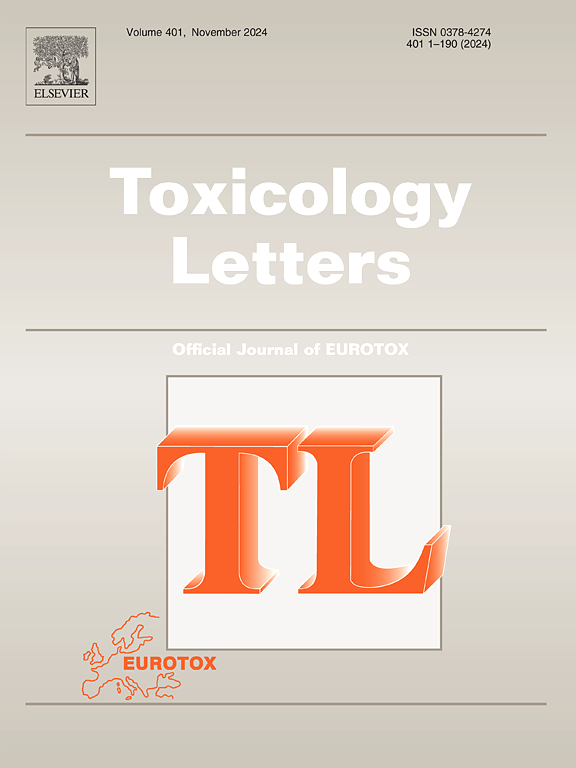Inhibition of placental 11β-HSD2 expression through cAMP/PKA signaling pathway induces intrauterine growth retardation
IF 2.9
3区 医学
Q2 TOXICOLOGY
引用次数: 0
Abstract
It is known that excessive exposure to maternal glucocorticoids during fetal development can cause fetal intrauterine growth retardation (IUGR) and 11β-hydroxysteroid dehydrogenase type 2 (11β-HSD2) plays an important role in the regulation of fetal glucocorticoid level. Our previous study has found that prenatal caffeine exposure (PCE) can inhibit placental 11β-HSD2 expression. However, the epigenetic mechanism and the role of 11β-HSD2 in PCE-induced IUGR remain undetermined. Pregnant Wistar rats were intragastrically administered caffeine (30 and 120 mg/kg·d) on gestational days 9–20. We found that caffeine decreased the fetal body weights, increased maternal/fetal serum and placental corticosterone levels; moreover, it increased placental early growth response factor 1 (EGR1) expression and decreased 11β-HSD2 expression. Further, in HTR-8/SVneo cells, caffeine inhibited the cAMP/PKA signal pathway, increased EGR1 expression, decreased 11β-HSD2 expression, and changed histone modifications (H3K9ac decrease, H3K9me2 increase) in the HSD11B2 promoter region. Adenylyl cyclase agonist and EGR1 knockdown all reversed the inhibition of 11β-HSD2 expression by caffeine. It is suggested that the cAMP/PKA/EGR1 signaling pathway mediates caffeine-induced 11β-HSD2 expression inhibition in placental trophoblasts. Finally, using clinical specimens, we confirmed the inhibition of cAMP/PKA signaling pathway, the increase of EGR1/SP1 expression ratio, and the decrease of 11β-HSD2 expression in IUGR placentas. Among them, 11β-HSD2 expression and neonatal birth weight were positively correlated with placental cAMP/PKA signaling pathway, but negatively correlated with EGR1/SP1 expression ratio. In conclusion, the cAMP/PKA signaling pathway and its regulated EGR1/SP1 expression ratio are common regulatory mechanisms of placental 11β-HSD2 in IUGR fetuses. This study elucidates the epigenetic mechanism of PCE on placental 11β-HSD2 expression. Combined with clinical verification, the common mechanism of placental 11β-HSD2 expression down-regulation and IUGR occurrence was proposed, which provided a new idea for exploring early warning and prevention targets of IUGR.
通过cAMP/PKA信号通路抑制胎盘11β-HSD2表达诱导宫内生长迟缓
已知胎儿发育过程中过量暴露于母体糖皮质激素可导致胎儿宫内生长迟缓(IUGR), 11β-羟基类固醇脱氢酶2型(11β-HSD2)在调节胎儿糖皮质激素水平中起重要作用。我们之前的研究发现,产前咖啡因暴露(PCE)可以抑制胎盘11β-HSD2的表达。然而,11β-HSD2在pce诱导的IUGR中的表观遗传机制和作用尚未确定。妊娠第9-20天Wistar大鼠灌胃咖啡因(30和120 mg/kg·d)。我们发现咖啡因降低胎儿体重,增加母胎血清和胎盘皮质酮水平;提高胎盘早期生长反应因子1 (EGR1)表达,降低11β-HSD2表达。此外,在HTR-8/SVneo细胞中,咖啡因抑制cAMP/PKA信号通路,增加EGR1表达,降低11β-HSD2表达,改变HSD11B2启动子区域组蛋白修饰(H3K9ac减少,H3K9me2增加)。腺苷酸环化酶激动剂和EGR1敲低均可逆转咖啡因对11β-HSD2表达的抑制。提示cAMP/PKA/EGR1信号通路介导咖啡因诱导的胎盘滋养细胞11β-HSD2表达抑制。最后,通过临床标本,我们证实了IUGR胎盘中cAMP/PKA信号通路的抑制,EGR1/SP1表达比例的增加,以及11β-HSD2表达的降低。其中,11β-HSD2表达与新生儿出生体重与胎盘cAMP/PKA信号通路呈正相关,与EGR1/SP1表达比负相关。综上所述,cAMP/PKA信号通路及其调控的EGR1/SP1表达比是IUGR胎儿胎盘11β-HSD2的共同调控机制。本研究阐明了PCE对胎盘11β-HSD2表达的表观遗传机制。结合临床验证,提出胎盘11β-HSD2表达下调与IUGR发生的共同机制,为探索IUGR的预警和预防靶点提供了新的思路。
本文章由计算机程序翻译,如有差异,请以英文原文为准。
求助全文
约1分钟内获得全文
求助全文
来源期刊

Toxicology letters
医学-毒理学
CiteScore
7.10
自引率
2.90%
发文量
897
审稿时长
33 days
期刊介绍:
An international journal for the rapid publication of novel reports on a range of aspects of toxicology, especially mechanisms of toxicity.
 求助内容:
求助内容: 应助结果提醒方式:
应助结果提醒方式:


